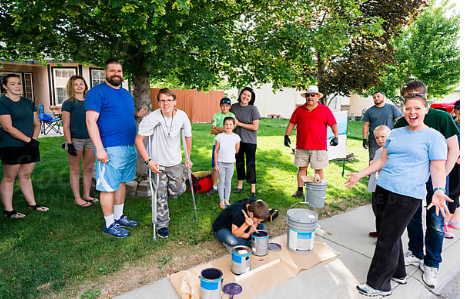





For community activators
When a community works together, anything is possible.
You might be already working in a role that’s already got great connections into your community’s infrastructure. But are you wanting to learn from people who have had success with their own lead-by-example initiative? Below is a list of some ideas, case studies and reports that aim to really help solidify your thinking in this space.

Take action on bigger community-led initiatives.
Community engagement initiatives for groups
- Our simple community vision building strategies
- Working with Tangata Whenua
- Read about running a community treasure hunt
Running a community garden
- Great learnings from Mataura’s experience early on and a more recent update on how their community garden is part of a bigger community transformation
- A guide to starting a community garden from Christchurch. Remember every initiative is different. Decide what ideas are useful for you, rather than treating other projects as templates you have to follow. Check out your local area for others running community gardens and see what support your local authorities offer.
Running community dinners and kai sharing
- So much can grow from sharing kai together at a community dinner. We can build trust, relationships, understanding and meaningful responses to community strengths, challenges and aspirations. Stone Soup is a wonderful example of what can be generated through sharing kai and a heart for growing stronger community.
- The impact of the work of food rescue organisations like Kaibosh and Kiwi Harvest around reducing food poverty and food waste is even deeper when strongly linked to local community-led development initiatives such as the Valley Kai Share group in Dunedin
- Small local kai sharing initiatives can be really simple, high on trust and low on rules. One example is the community fruit and veggie stands idea above, for sharing surplus garden produce.
- Find a community pantry near you
Community newsletters and their influence on wider community action
- Te Kowhai is a small village with a big vision. Their community newsletter played a key part in connecting people and possibilities into projects.
- On a smaller scale, see what we can learn from one person starting a community newsletter and what evolved from that.
How to create a Timebank
Thanks Project Lyttleton for sharing your learning about a great way to engage a community’s strengths and skills in a powerful alternative economy.
How to set up a Repair Café
Here are some practical resources from Auckland and a story about connecting communities one repair at a time.
Communities shaping fun, creative community bumping places and spaces
- The Colville Project, a rural, remote community are mobilising people and resources for an important local community and health hub with creative, fun events.
- South Alive in Invercargill is working on urban rejuvenation around the physical and social environment that supports this community as a great place to live, work and play in.
- Think how you can, not why you can’t says the group getting the Hundertwasser Art Centre in Whangarei established.
- Nothing like Cherry Chaos – a huge food fight challenge – for welcoming and connecting seasonal workers and locals in Roxburgh, Central Otago.
- Whangaroa Community Playground had a huge makeover thanks to a strong group of young and old volunteers, tradespeople, parents and retired people in the Far North. They say it’s just the beginning for this small community.
Environment, Conservation and Sustainability action
- Halo Whakatāne is taking conservation to another level, creating a sanctuary for the whole community, beyond their initial success with a Kiwi project.
- Read how one person started the first predator free community in a built up residential area in Aotearoa by bringing the community together around a common goal.
Grey Lynn Transition Town’s initiatives have a proud history of change over the last decade that we can all learn from.
